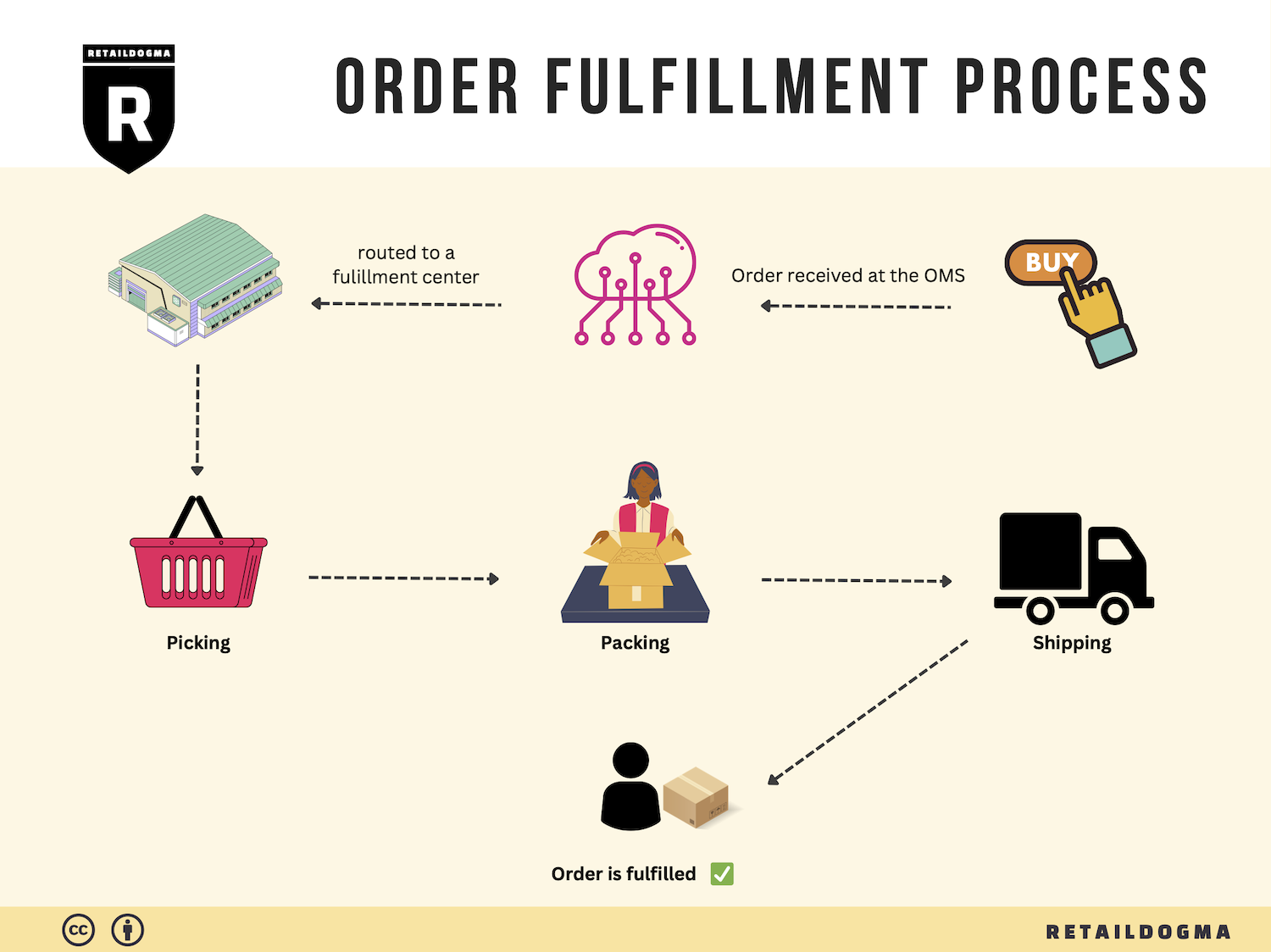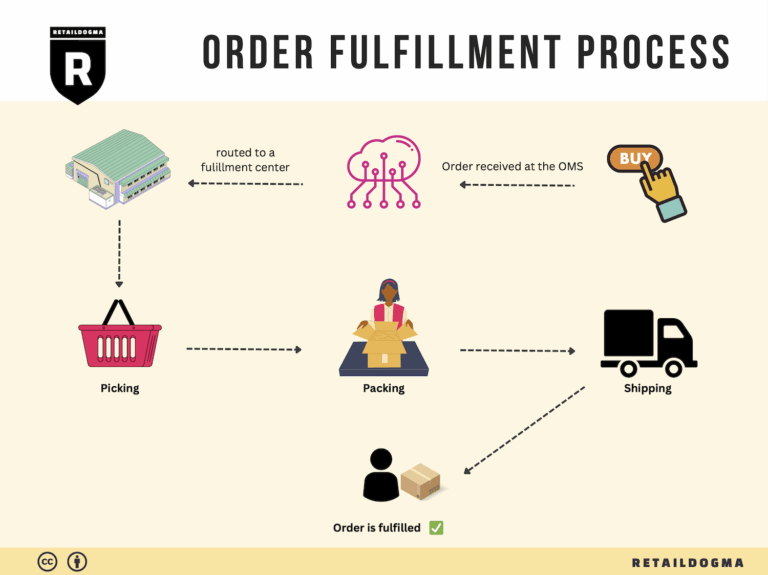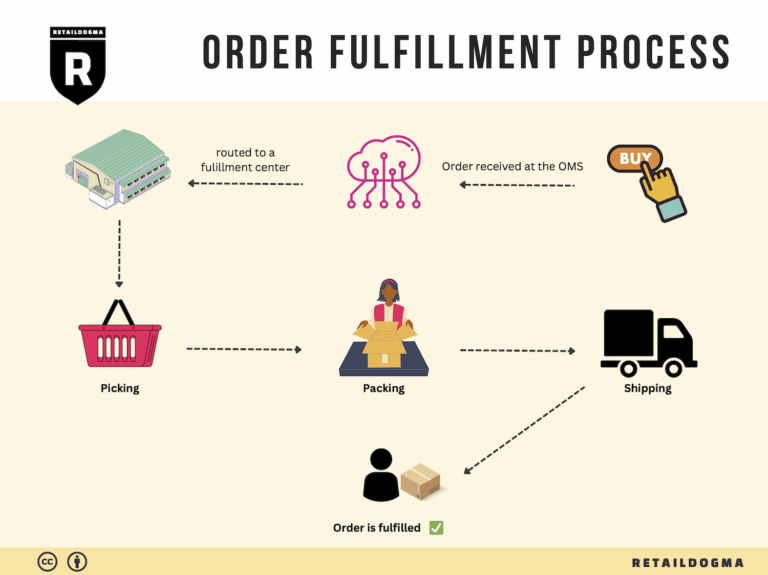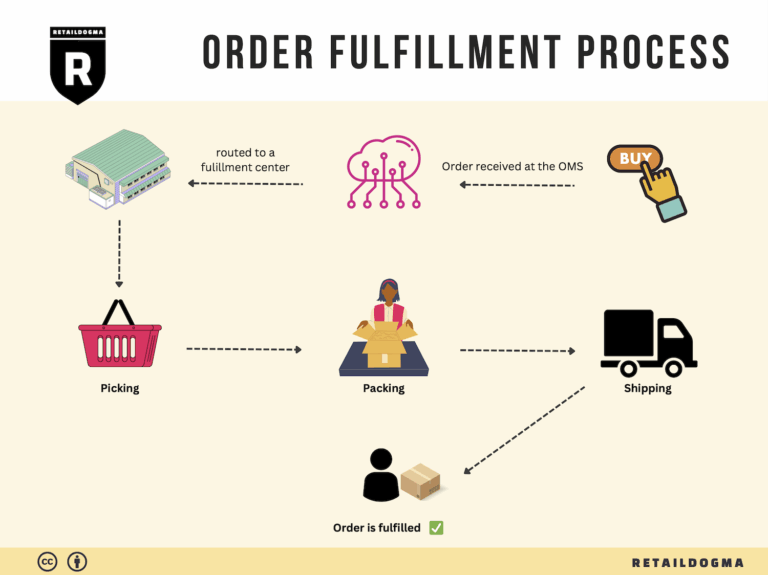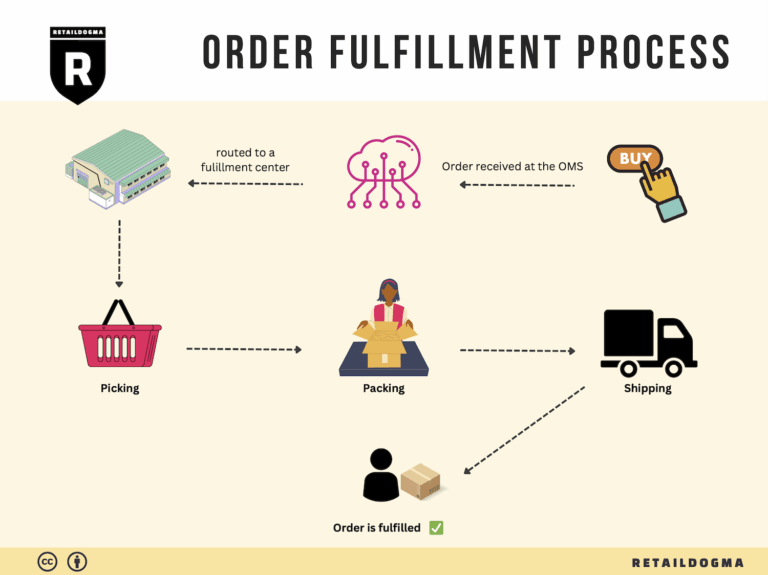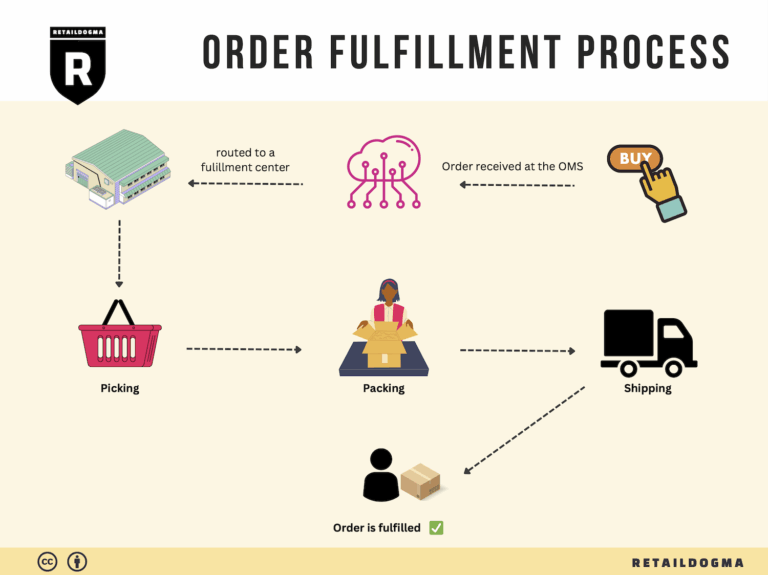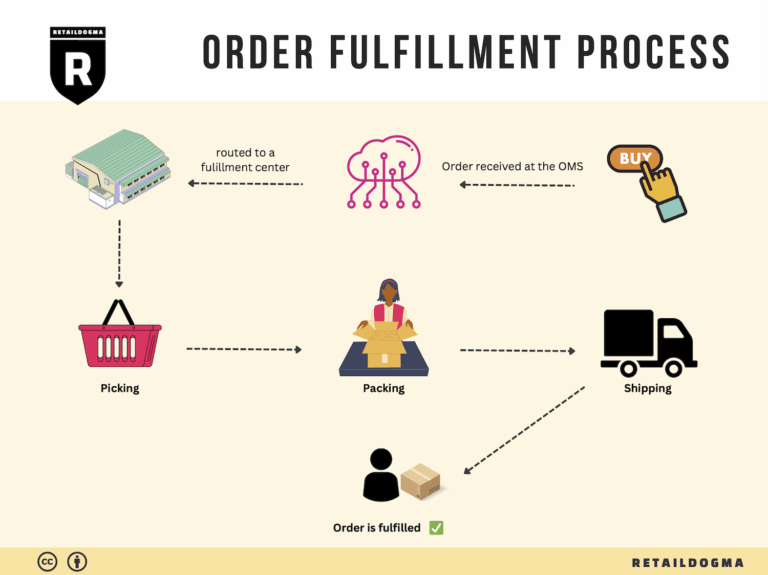Ecommerce Fulfillment Services: The Ultimate Guide (2025)
What is E-commerce Fulfillment? An Introduction for Growing Businesses
Understanding the Challenges of E-commerce Fulfillment
As a growing e-commerce business owner, you might find yourself grappling with the overwhelming demands of packing and shipping orders. The thrill of sales can quickly turn into a logistical nightmare, especially when managing inventory, ensuring timely deliveries, and maintaining customer satisfaction. This is where effective e-commerce fulfillment comes into play—a crucial aspect that can either make or break your operational efficiency and customer experience.
What is E-commerce Fulfillment?
At its core, e-commerce fulfillment is the process of getting a product from your inventory into the hands of your customer. This involves several steps, including order processing, inventory management, picking and packing products, shipping, and handling returns. For many entrepreneurs, the fulfillment process can become complex and time-consuming, often detracting from their ability to focus on growth and customer engagement.
What This Guide Covers
In this comprehensive guide, we will explore the various models of e-commerce fulfillment that can help you streamline your operations. You’ll learn about:
- Third-Party Logistics (3PL): These providers can handle all aspects of fulfillment, allowing you to focus on your core business functions.
- Fulfillment by Amazon (FBA): A popular choice for many sellers, FBA offers access to Amazon’s vast customer base while managing storage, packing, and shipping.
- In-House Fulfillment: For some businesses, managing fulfillment internally may be more cost-effective, especially for those with lower order volumes.
We will also delve into the core services offered by fulfillment partners, including inventory storage, order management, and shipping solutions. You’ll gain insights on how to choose the right fulfillment partner based on your unique business needs, including factors like service levels, technology integration, and geographic reach.
Pricing Considerations
Understanding the cost structure of fulfillment services is essential for maintaining profitability. We will cover key pricing elements, such as storage fees, pick and pack costs, shipping rates, and any additional charges that may arise, helping you make informed financial decisions.
Empowering Smart Logistics Decisions
Ultimately, this guide aims to empower you to make informed decisions about your logistics strategy. By understanding the ins and outs of e-commerce fulfillment, you can optimize your operations, enhance customer satisfaction, and scale your business more effectively. Whether you choose to partner with a fulfillment provider or manage logistics in-house, having a clear understanding of your options is key to navigating the complexities of e-commerce logistics.

What You’ll Learn In This Guide
- What is E-commerce Fulfillment? An Introduction for Growing Businesses
- The Order Fulfillment Process: From ‘Buy’ Button to Customer’s Door
- Comparing Fulfillment Models: In-House vs. 3PL vs. Dropshipping
- A Deep Dive into Amazon FBA: Pros, Cons, and Who It’s For
- Core Services Offered by Fulfillment Centers
- How to Choose a Fulfillment Partner: A 6-Point Checklist
- Understanding Fulfillment Pricing: A Breakdown of Common Fees
- Frequently Asked Questions (FAQs) about Fulfillment
- Conclusion: Is Outsourcing Fulfillment the Right Move for Your Business?
- Important Disclaimer
The Order Fulfillment Process: From ‘Buy’ Button to Customer’s Door
1. Receiving Inventory
The order fulfillment process begins with receiving inventory, where products are accepted from suppliers into your warehouse or fulfillment center. This step is crucial as it establishes the foundation for your inventory management system. During this phase, items are checked against purchase orders to verify quantities and conditions, ensuring that what was ordered matches what is received.
A key term associated with this step is SKU (Stock Keeping Unit). Each item should have a unique SKU, which helps in tracking inventory levels, managing stock efficiently, and simplifying future order processing. Properly managing inventory at this stage reduces discrepancies and minimizes the risk of stockouts or overstock situations, which can adversely affect your order fulfillment efficiency.
2. Warehouse Storage
Once inventory is received and verified, the next step is warehouse storage. This involves organizing and storing products in a manner that facilitates easy access and retrieval during the order picking process. Effective warehouse storage strategies can include categorizing items based on size, type, or demand frequency to optimize space utilization and efficiency.
A critical term here is slotting. Slotting refers to the strategic placement of products within the warehouse to minimize the distance pickers must travel to retrieve items. Efficient slotting not only speeds up the picking process but also helps in managing inventory turnover, as high-demand items are placed closer to shipping areas. By ensuring that your inventory is well-organized, you can significantly enhance the speed and accuracy of order fulfillment.
3. Order Picking
Order picking is the process of retrieving items from the warehouse to fulfill a customer’s order. This step is vital as it directly impacts order accuracy and customer satisfaction. Efficient picking methods can vary from single-order picking to batch picking, where multiple orders are processed simultaneously, depending on your operation scale and order volume.
The term pick lists is essential here. A pick list is a document or digital record that outlines the items and quantities needed for each order. It serves as a guide for pickers, ensuring they gather the correct products efficiently. Implementing technology such as barcode scanning or pick-to-light systems can further streamline the picking process, reducing errors and speeding up order fulfillment times.
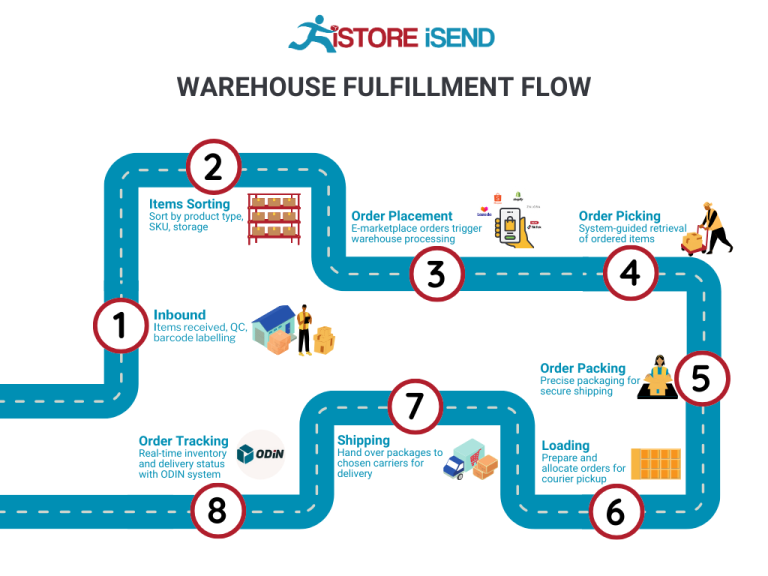
4. Order Packing
After items are picked, they move to the packing stage. Proper packing is crucial to prevent damage during transit and ensure that customers receive their orders in pristine condition. This step involves selecting appropriate packaging materials, securely packing items, and generating shipping labels.
A key term in packing is dimensional weight (DIM weight). This concept refers to a pricing technique used by carriers based on the dimensions of the package rather than just its weight. Understanding DIM weight can help you choose the right packaging to minimize shipping costs while ensuring products are adequately protected. A well-executed packing process not only enhances customer satisfaction but can also lead to cost savings on shipping.
5. Shipping & Delivery
The final step in the order fulfillment process is shipping and delivery. This phase encompasses the transfer of packed orders to the shipping carriers and the eventual delivery to the customer’s doorstep. The efficiency of this step is critical, as it influences overall customer satisfaction and repeat business.
A significant term associated with shipping is last-mile delivery. This term refers to the final leg of the shipping process, where the package is delivered from a distribution center to the end customer. Optimizing last-mile delivery can reduce shipping costs and enhance delivery speed, which are vital in meeting customer expectations in today’s fast-paced e-commerce environment. Utilizing advanced shipping software can help manage shipping routes, track deliveries in real-time, and provide customers with accurate delivery estimates.
In conclusion, a well-structured order fulfillment process is essential for scaling e-commerce operations. By focusing on each step—receiving inventory, warehouse storage, order picking, order packing, and shipping & delivery—you can enhance efficiency, reduce costs, and ultimately improve customer satisfaction. Implementing best practices and leveraging technology at each stage will not only streamline operations but also support your growth ambitions in the competitive e-commerce landscape.
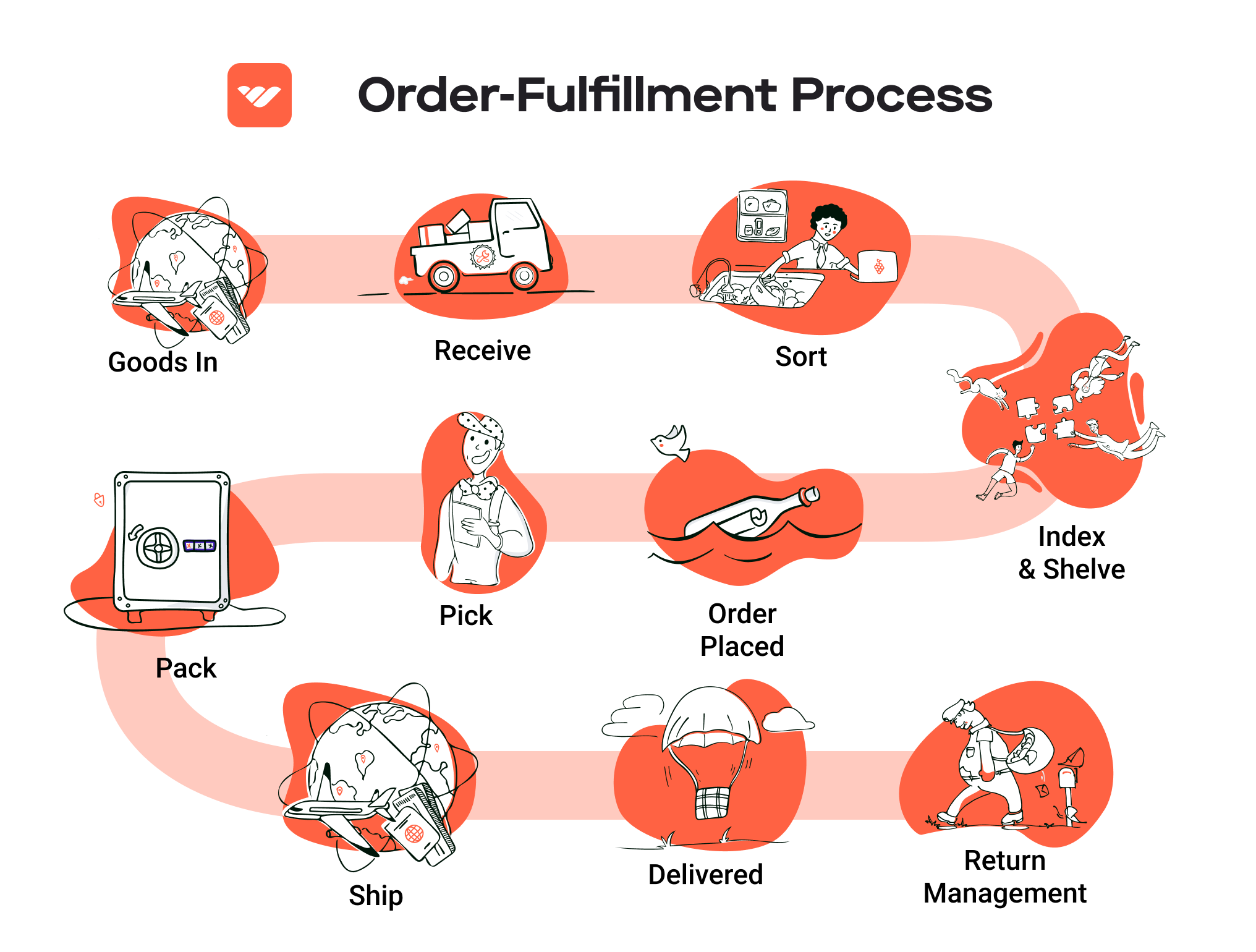
Comparing Fulfillment Models: In-House vs. 3PL vs. Dropshipping
Fulfillment Model Comparison
| Model | Who Handles Inventory | Best For (Business Stage) | Key Advantage | Key Disadvantage |
|---|---|---|---|---|
| In-House Fulfillment | The business itself | Established businesses | Full control over operations | High overhead costs |
| Third-Party Logistics (3PL) | 3PL provider | Growing to large businesses | Scalability and flexibility | Less control over inventory |
| Dropshipping | Supplier/vendor | Startups and small businesses | Low upfront investment | Longer shipping times |
In-House Fulfillment
In-house fulfillment involves managing all aspects of order processing and inventory within your own facilities. This model is best suited for established businesses that have a stable demand and sufficient capital to invest in storage, staffing, and technology. The key advantage of in-house fulfillment is the complete control it provides over the entire supply chain. Businesses can optimize their processes, maintain quality standards, and respond quickly to customer demands. However, this control comes at a cost—overhead expenses can be significant due to the need for warehousing, staff salaries, and technology infrastructure. Additionally, as order volumes fluctuate, businesses may struggle with excess inventory or inadequate capacity, leading to inefficiencies.
Third-Party Logistics (3PL)
Third-party logistics (3PL) is an outsourcing model where businesses partner with specialized logistics providers to manage their warehousing, inventory, and order fulfillment. This model is ideal for growing to large businesses that require scalability and flexibility without the burden of managing logistics in-house. The key advantage of 3PL is the ability to scale operations quickly and efficiently, allowing businesses to focus on core activities such as marketing and product development. Furthermore, 3PL providers often have established networks and technologies that can optimize shipping and fulfillment processes. However, the downside is that businesses relinquish some control over their inventory and operations. This can lead to challenges in communication and potential service inconsistencies if the 3PL provider does not meet expectations.
Dropshipping
Dropshipping is a fulfillment model where the retailer does not hold inventory but instead transfers customer orders directly to a supplier, who then ships the products directly to the customer. This model is particularly well-suited for startups and small businesses that want to minimize upfront investment and risk. The primary advantage of dropshipping is the low barrier to entry, allowing entrepreneurs to start selling without significant capital tied up in inventory. Additionally, it enables a wide range of product offerings without the need for warehousing. However, dropshipping comes with its challenges, including longer shipping times, potential quality control issues, and reduced profit margins due to reliance on suppliers. Furthermore, since the retailer has less control over inventory and fulfillment, managing customer expectations can be more difficult, especially during peak seasons or supply chain disruptions.
Conclusion
Choosing the right fulfillment model is critical to the success of an e-commerce business. Each model—In-House Fulfillment, Third-Party Logistics (3PL), and Dropshipping—offers unique advantages and disadvantages that can significantly impact operational efficiency, customer satisfaction, and overall profitability. Understanding your business stage, resources, and growth objectives will help you make an informed decision that aligns with your strategic goals. As your business evolves, you may find that a combination of these models may provide the optimal solution for scaling your operations effectively.
A Deep Dive into Amazon FBA: Pros, Cons, and Who It’s For
Understanding Fulfillment by Amazon (FBA)
Fulfillment by Amazon (FBA) is a service provided by Amazon that enables sellers to store their products in Amazon’s fulfillment centers. Amazon then takes care of storage, packaging, and shipping of the products to customers, as well as customer service and returns management. This service allows e-commerce businesses to leverage Amazon’s vast logistics network, ensuring swift delivery and enhancing customer satisfaction.
How FBA Works
-
Product Listing: Sellers create product listings on Amazon and choose to enroll those products in the FBA program.
-
Shipping Inventory: Sellers ship their inventory to Amazon’s fulfillment centers. Amazon provides guidelines on how to prepare and package products for shipment.
-
Storage: Once received, Amazon stores the products in its warehouses. Sellers can monitor their inventory levels through the Seller Central dashboard.
-
Order Fulfillment: When a customer orders a product, Amazon picks, packs, and ships the item on behalf of the seller.
-
Customer Service: Amazon handles all customer service inquiries and returns related to FBA products, allowing sellers to focus on other aspects of their business.
-
Fees: Sellers are charged fees for storage and fulfillment services. These fees can vary based on the size and weight of the products, as well as the time of year.
Pros of Using Amazon FBA
Prime Eligibility
One of the most significant advantages of FBA is that it makes your products eligible for Amazon Prime. Prime members enjoy free two-day shipping, which can significantly increase your sales volume as Prime customers tend to prefer products that are eligible for fast delivery.
Customer Trust
Amazon is synonymous with trust and reliability. By using FBA, sellers can leverage Amazon’s reputation, which can lead to higher conversion rates. Customers feel more secure purchasing products that are backed by Amazon’s fulfillment and customer service.
Multi-Channel Fulfillment
FBA isn’t limited to just Amazon.com. Sellers can also use FBA to fulfill orders from other sales channels, including their own websites or other e-commerce platforms. This flexibility allows businesses to centralize their inventory management and streamline operations across multiple sales channels.
Scalability
FBA allows sellers to scale their operations without the overhead associated with warehousing and logistics. With Amazon handling fulfillment, sellers can focus on marketing and expanding their product lines without worrying about the complexities of order fulfillment.
Time Efficiency
By outsourcing fulfillment to Amazon, sellers can save time on packing, shipping, and customer service. This efficiency allows them to concentrate on other critical areas of their business, such as product development and marketing strategies.
Cons of Using Amazon FBA
High Fees
One of the primary drawbacks of FBA is the cost. Sellers incur various fees, including storage fees for keeping inventory in Amazon’s warehouses and fulfillment fees based on the size and weight of the products. During peak seasons, such as holidays, storage fees can significantly increase, impacting profit margins.
Strict Inventory Rules
Amazon has stringent inventory management policies. Sellers must adhere to specific guidelines regarding inventory levels and performance metrics. Failure to comply can result in penalties, such as additional fees or the removal of inventory from Amazon’s warehouses.
Commingling Risks
FBA products are often commingled, meaning that inventory from different sellers is stored together. This can lead to potential issues, such as receiving the wrong product or counterfeit items. Sellers are responsible for ensuring the quality of their products, but commingling complicates this process.
Loss of Control
When using FBA, sellers relinquish some control over the fulfillment process. This includes aspects like packaging and shipping speed, which can affect brand perception. If Amazon experiences delays, it can directly impact the seller’s reputation and customer satisfaction.
Competition with Amazon
Sellers using FBA may find themselves competing directly with Amazon itself, especially if they sell common products. Amazon can often undercut prices, making it difficult for independent sellers to maintain competitive pricing.
Who is FBA Best For?
Fulfillment by Amazon is particularly beneficial for:
-
Small to Medium-Sized Sellers: Those looking to scale their businesses without investing heavily in logistics can benefit from the resources and infrastructure that FBA provides.
-
Brands with Established Products: Sellers who already have a proven product and want to reach a broader audience can leverage Amazon’s platform to increase visibility and sales.
-
E-commerce Entrepreneurs: New entrepreneurs looking for a streamlined way to manage logistics and customer service can find FBA to be an effective solution that allows them to focus on growth.
-
Sellers with High Sales Volume: Businesses that can move a high volume of products can offset the costs associated with FBA, making it a more economically viable option.
-
Multi-Channel Sellers: Those operating on various platforms can benefit from using FBA to manage their logistics seamlessly across different sales channels.
In conclusion, Fulfillment by Amazon can be a powerful tool for e-commerce businesses seeking to enhance their operational efficiency and customer satisfaction. However, it’s essential to weigh the pros and cons carefully to determine if FBA aligns with your business goals and operational capabilities.
Core Services Offered by Fulfillment Centers
Inventory Management & Warehousing
Inventory management and warehousing are foundational services provided by fulfillment centers that directly impact an e-commerce business’s efficiency and profitability. Fulfillment centers utilize sophisticated software systems to track inventory levels in real time, ensuring that stock is monitored and managed effectively. This includes keeping tabs on product quantities, managing stock replenishments, and forecasting demand based on historical sales data.
Benefits:
1. Cost Efficiency: Proper inventory management minimizes excess stock, reducing holding costs and the risk of obsolescence.
2. Space Optimization: Warehousing solutions are designed to maximize storage space, employing various storage techniques such as shelving, racking, and pallet systems to accommodate different product types.
3. Improved Order Fulfillment Speed: With organized inventory, fulfillment centers can quickly locate and ship products, enhancing customer satisfaction through faster delivery times.
4. Data-Driven Decisions: Advanced inventory management systems provide analytics that help businesses make informed decisions about purchasing, stocking, and sales strategies, ultimately leading to better alignment with market demand.
Pick and Pack Services
Pick and pack services are crucial for e-commerce operations, as they involve the process of selecting items from inventory (picking) and preparing them for shipment (packing). Fulfillment centers employ trained staff and automated systems to streamline this process. Orders are received electronically, and the system generates pick lists that guide staff to the correct items in the warehouse.
Benefits:
1. Accuracy: Automated systems reduce human error in order fulfillment, ensuring that customers receive the correct products.
2. Scalability: As an e-commerce business grows, fulfillment centers can easily scale their pick and pack operations to handle increased order volumes without compromising efficiency.
3. Customization: Many fulfillment centers offer customizable packing options, allowing businesses to create branded packaging that enhances the customer experience.
4. Time Savings: By outsourcing pick and pack services, e-commerce businesses can focus on core activities such as marketing and product development rather than logistical operations, leading to overall business growth.
Kitting and Assembly
Kitting and assembly services involve bundling products together or assembling items into a final product before shipping. This is particularly beneficial for e-commerce businesses that sell products that are often purchased together or require assembly. Fulfillment centers manage this process by organizing the necessary components and ensuring that they are packaged efficiently.
Benefits:
1. Enhanced Product Offering: Kitting allows businesses to create attractive bundled offers, increasing perceived value and potentially boosting sales.
2. Streamlined Operations: By outsourcing kitting and assembly, businesses can reduce the complexity of their operations, allowing them to focus on other important areas like customer service and product innovation.
3. Inventory Control: Kitting can also improve inventory management by consolidating various components into a single SKU, simplifying stock tracking and replenishment.
4. Increased Customer Satisfaction: Well-assembled kits that arrive ready to use enhance the customer experience, leading to higher satisfaction and repeat purchases.
Returns Management (Reverse Logistics)
Returns management, or reverse logistics, is a critical service that addresses the process of handling returned products. This service is essential in e-commerce, where return rates can be significant due to various factors such as sizing issues, product defects, or customer dissatisfaction. Fulfillment centers streamline the returns process by providing clear instructions, managing return authorizations, and efficiently processing returned items.
Benefits:
1. Customer Retention: A hassle-free returns process enhances customer trust and loyalty, encouraging repeat business even after a return.
2. Operational Efficiency: Fulfillment centers can quickly assess returned items for resale, refurbishing, or recycling, minimizing losses and maximizing the potential for recovery.
3. Data Insights: Analyzing return data helps businesses understand customer preferences and product performance, informing future product development and inventory decisions.
4. Cost Reduction: Efficient returns management can reduce the costs associated with returns processing and logistics, ultimately improving the bottom line.
Conclusion
In summary, fulfillment centers provide a suite of core services that are indispensable for e-commerce businesses looking to scale efficiently. By leveraging services such as inventory management, pick and pack, kitting and assembly, and returns management, businesses can enhance their operational efficiency, improve customer satisfaction, and ultimately drive growth. As e-commerce continues to evolve, partnering with a reliable fulfillment center can provide a competitive edge in a crowded marketplace.
How to Choose a Fulfillment Partner: A 6-Point Checklist
Location & Warehouse Network
When selecting a fulfillment partner, the geographical location of their warehouses is critical. A well-distributed network can significantly affect shipping times and costs, directly impacting customer satisfaction.
Why It Matters:
– Shipping Speed: Proximity to your customer base can reduce delivery times, which is increasingly important in today’s fast-paced e-commerce environment.
– Cost Efficiency: Shipping from a nearby warehouse can lower shipping costs, especially for large or heavy items.
Questions to Ask:
1. Where are your warehouses located, and how does that align with my primary customer demographics?
2. Do you have multiple locations to ensure coverage for my target markets?
3. What is your strategy for expanding your warehouse network as my business grows?
Technology & Integrations
In an era where technology drives efficiency, the fulfillment partner’s technology stack and integration capabilities with your existing systems can make or break your operations.
Why It Matters:
– Automation and Efficiency: Advanced technology can streamline order processing and inventory management, reducing human error and operational costs.
– Seamless Operations: Integration with your e-commerce platform (like Shopify, WooCommerce, etc.) is vital for real-time inventory updates and order tracking.
Questions to Ask:
1. What technologies do you use for inventory management, order processing, and shipping?
2. Can your system integrate with my e-commerce platform? If so, what is the process and timeframe?
3. How do you handle data security and compliance with industry standards?
Specializations (e.g., Cold Storage, Oversized Items)
Depending on your product range, your fulfillment partner may need specific capabilities, such as cold storage for perishables or special handling for oversized items.
Why It Matters:
– Product Suitability: Specialized storage and handling can prevent damage and ensure compliance with safety regulations.
– Expertise: A partner with experience in your specific product category can provide insights and efficiencies that generalists may lack.
Questions to Ask:
1. What specific types of products do you specialize in fulfilling?
2. Do you have the facilities and expertise to handle my specific product requirements?
3. Can you provide examples of how you’ve successfully managed similar products for other clients?
Scalability & Capacity
As your business grows, your fulfillment partner should be able to scale with you. Understanding their capacity for handling increased order volumes is crucial.
Why It Matters:
– Future-Proofing: A partner that can scale operations seamlessly will save you the hassle and cost of switching providers as your needs grow.
– Operational Stability: Ensuring they can handle peak seasons and unexpected surges in demand is vital for maintaining customer satisfaction.
Questions to Ask:
1. What is your current capacity for fulfilling orders, and how do you manage peak seasons?
2. How quickly can you scale operations if my order volume increases significantly?
3. Can you provide case studies or examples of how you’ve supported clients during their growth phases?
Pricing and Contracts
Understanding the pricing structure and contract terms is essential to avoid unexpected costs and ensure that you are getting value for your investment.
Why It Matters:
– Budget Management: Clear pricing helps you manage costs and align them with your financial goals.
– Contract Flexibility: Understanding the terms can prevent costly penalties or issues if your business needs change.
Questions to Ask:
1. What is your pricing structure for fulfillment services (e.g., per order, storage fees, etc.)?
2. Are there any hidden fees I should be aware of (e.g., for returns, special handling)?
3. What are the contract terms, and is there flexibility to adjust as my business needs change?
Customer Support & Reviews
Strong customer support can be a game-changer in your fulfillment experience. Additionally, reviews and testimonials can provide insights into how well the partner performs.
Why It Matters:
– Responsive Support: Issues can arise at any time, and having a partner that offers reliable support can minimize disruptions.
– Reputation: Reviews from other clients can reveal the partner’s strengths and weaknesses, helping you make an informed decision.
Questions to Ask:
1. What support channels do you offer (e.g., phone, email, chat), and what are your response times?
2. Can you provide references or case studies from current or past clients?
3. How do you handle issues or errors in order fulfillment, and what is your process for resolution?
By utilizing this checklist, e-commerce business owners and operations managers can make informed decisions when selecting a fulfillment partner, ensuring that they align with their operational needs and growth ambitions. A strategic choice in a fulfillment partner can enhance efficiency, customer satisfaction, and ultimately, profitability.
Understanding Fulfillment Pricing: A Breakdown of Common Fees
Initial Setup Fees
Initial setup fees are one-time charges that e-commerce businesses incur when first establishing a relationship with a fulfillment provider. These fees can cover a variety of services, including account setup, integration with your existing e-commerce platform, and initial training for staff on how to use the fulfillment system. The cost of these fees can vary significantly based on the complexity of your operations and the technology involved.
To calculate initial setup fees, fulfillment providers often consider factors such as the number of SKUs to be managed, the level of customization needed for the software integration, and any unique operational requirements specific to your business. It’s crucial to have a clear understanding of what these fees entail, as they can range from a few hundred to several thousand dollars, depending on the provider and your specific needs.
Receiving Fees
Receiving fees are charged by fulfillment centers to process incoming inventory. This fee typically covers the labor and resources required to unload, inspect, and store products upon arrival. The calculation of receiving fees can be based on several factors, including the volume of inventory, the number of distinct SKUs, and the complexity of the receiving process.
For example, some fulfillment centers may charge a flat fee per shipment received, while others might charge based on the weight or quantity of items. Understanding how these fees are structured is essential for budgeting purposes, especially if your inventory levels fluctuate frequently.
Storage Fees (per pallet/bin)
Storage fees are recurring charges that apply to the inventory you keep in a fulfillment center. These fees are calculated based on the amount of space your products occupy, often measured in pallets or bins. The storage fee can vary by location and the type of products stored, with some items requiring specialized storage conditions.
To determine your storage costs, fulfillment providers may implement a monthly charge per pallet or bin. Additionally, many facilities will have tiered pricing based on the volume of space used—meaning that larger storage commitments might benefit from reduced rates. It’s important to assess your inventory turnover rates and storage needs to negotiate the best possible terms.
Pick & Pack Fees (per item/order)
Pick and pack fees cover the labor involved in selecting items from inventory and packing them for shipment. This fee is typically charged per item or per order, depending on the fulfillment provider’s pricing structure.
The calculation of pick and pack fees can vary widely based on the complexity of the order. For instance, orders with multiple SKUs may incur higher fees than single-item orders due to the additional labor involved in picking multiple items and packing them correctly. Understanding how your order volume and variety impact these fees is crucial for maintaining cost-effective operations.
Shipping Fees
Shipping fees are one of the most significant costs associated with fulfillment. These fees cover the transportation of goods from the fulfillment center to the customer’s doorstep. Shipping costs can vary based on several factors, including the shipping carrier used, the destination, the weight and dimensions of the package, and the chosen delivery speed.
Fulfillment providers may offer different shipping options—ranging from standard to expedited services—each with its own fee structure. Some providers may also offer discounted shipping rates through partnerships with carriers, which can significantly reduce your overall shipping costs. It’s essential to understand the various shipping options available and how they align with your customer service goals and budget.
Tips for Getting an Accurate Quote
-
Detailed Inventory List: Provide a comprehensive list of your SKUs, including dimensions, weight, and any special handling requirements. This helps fulfillment providers give you a more accurate quote based on your specific needs.
-
Volume Estimates: Share your expected order volume and frequency. Understanding your sales forecasts will help providers estimate storage, pick, and pack fees more accurately.
-
Shipping Preferences: Specify your preferred shipping methods and regions. This information allows fulfillment centers to tailor their shipping fees based on your logistics strategy.
-
Ask About Hidden Fees: Inquire about any additional charges that may not be included in the initial quote, such as fees for returns, order changes, or seasonal surcharges.
-
Evaluate Multiple Providers: Don’t settle for the first quote. Comparing multiple fulfillment providers can help you identify the best pricing model for your business needs.
By carefully analyzing these common fees and considering the outlined tips, e-commerce businesses can better manage their fulfillment costs and optimize their operations for growth.
Frequently Asked Questions (FAQs) about Fulfillment
1. What is a fulfillment engine?
A fulfillment engine is a software solution designed to streamline and automate the order fulfillment process for e-commerce businesses. It connects various elements of the supply chain, including inventory management, order processing, and shipping logistics, to ensure efficient and timely delivery of products to customers.
2. How does a fulfillment engine benefit my e-commerce business?
Using a fulfillment engine can significantly enhance operational efficiency by automating manual processes, reducing errors, and optimizing shipping routes. This results in faster order processing, lower shipping costs, improved customer satisfaction, and the ability to scale your business without a proportional increase in operational complexity.
3. What’s the difference between a warehouse and a fulfillment center?
A warehouse is primarily a storage space for goods, focusing on inventory management and bulk storage. In contrast, a fulfillment center specializes in processing and shipping orders quickly. Fulfillment centers are equipped with technology to handle order picking, packing, and shipping, making them ideal for e-commerce businesses that require speed and efficiency.
4. What is a 3PL (Third-Party Logistics)?
A 3PL is a service provider that manages logistics operations on behalf of another company. This includes warehousing, inventory management, order fulfillment, and transportation. Utilizing a 3PL can help e-commerce businesses reduce operational costs and focus on core activities like marketing and sales, while leaving logistics to the experts.
5. How much do fulfillment services cost?
Fulfillment service costs can vary based on several factors, including the volume of orders, the complexity of the products being shipped, and the specific services required (e.g., storage, picking, packing, shipping). Generally, costs may include per-order fees, storage fees, and shipping costs. It’s essential to evaluate different providers to find a solution that aligns with your budget and operational needs.
6. Can a fulfillment engine integrate with my existing e-commerce platform?
Yes, most modern fulfillment engines offer integration capabilities with popular e-commerce platforms such as Shopify, WooCommerce, and Magento. This allows for seamless data transfer, enabling automatic order processing and inventory updates, which enhances operational efficiency.
7. What role does automation play in a fulfillment engine?
Automation in a fulfillment engine helps streamline order management, inventory tracking, and shipping processes. By minimizing manual interventions, automation reduces the likelihood of errors, speeds up processing times, and allows staff to focus on more strategic tasks, ultimately leading to improved service levels and customer satisfaction.
8. How can I ensure accurate inventory management with a fulfillment engine?
To ensure accurate inventory management, choose a fulfillment engine that provides real-time inventory tracking and updates. This allows you to monitor stock levels, receive alerts for low inventory, and prevent overselling or stockouts, ensuring that you can meet customer demand without disruption.
9. What features should I look for in a fulfillment engine?
Key features to consider when selecting a fulfillment engine include:
– Integration capabilities with your existing systems
– Real-time inventory tracking
– Automated order processing
– Shipping optimization tools
– Reporting and analytics for performance tracking
– Scalability to support growth
10. How does a fulfillment engine improve shipping efficiency?
A fulfillment engine enhances shipping efficiency by intelligently routing orders based on cost and delivery speed, consolidating shipments where possible, and automating the selection of shipping carriers. This not only reduces shipping costs but also ensures timely deliveries, which can lead to increased customer satisfaction and loyalty.
Conclusion: Is Outsourcing Fulfillment the Right Move for Your Business?
Evaluating the Benefits of Outsourcing Fulfillment
Outsourcing fulfillment can be a game-changer for e-commerce businesses looking to scale efficiently. By leveraging a fulfillment service, you can save valuable time and resources. This allows you to focus on core business activities such as marketing, product development, and customer engagement, rather than getting bogged down in logistical challenges.
One of the primary advantages of partnering with a fulfillment provider is scalability. As your business grows, so do the complexities of order management and shipping. A capable fulfillment partner can seamlessly adapt to increased order volumes, manage inventory fluctuations, and handle peak seasons without compromising service quality. This flexibility ensures that you can respond to market demands swiftly, enhancing your competitive edge.
Moreover, fulfillment services bring a wealth of expertise to the table. With specialized knowledge in logistics, shipping regulations, and supply chain management, these partners can optimize your fulfillment processes. They often utilize advanced technology and automation, which can lead to improved order accuracy, faster shipping times, and reduced costs. This not only enhances customer satisfaction but also boosts your brand’s reputation.
However, choosing the right fulfillment partner is critical to realizing these benefits. A poor fit can lead to inefficiencies and customer dissatisfaction. Therefore, it’s essential to conduct thorough research and consider factors such as technology integration, service offerings, and customer support.
Take Action: Audit Your Current Shipping Process
To determine if outsourcing fulfillment is the right next step for your business, start by auditing your current shipping processes. Assess your operational efficiency, costs, and customer feedback. Identify pain points and growth opportunities. This analysis will guide you in making informed decisions about potential partnerships that can propel your business forward. Taking this proactive step can unlock new avenues for growth and operational excellence.
Important Disclaimer
⚠️ Important Disclaimer
The information in this guide is for educational purposes. Fulfillment services, pricing, and platform features change frequently. Always conduct your own due diligence and consult with providers directly before making business decisions.
